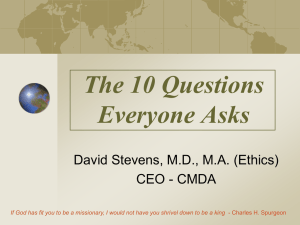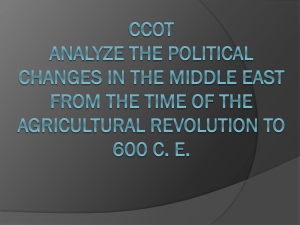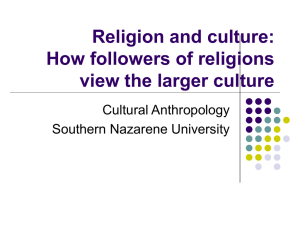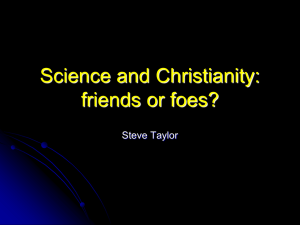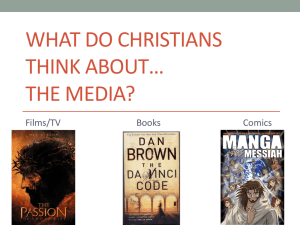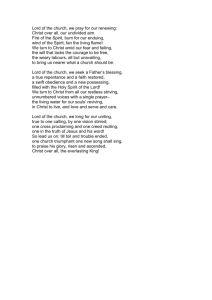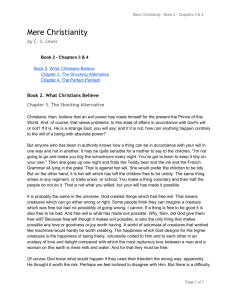Culture and Christianity
advertisement
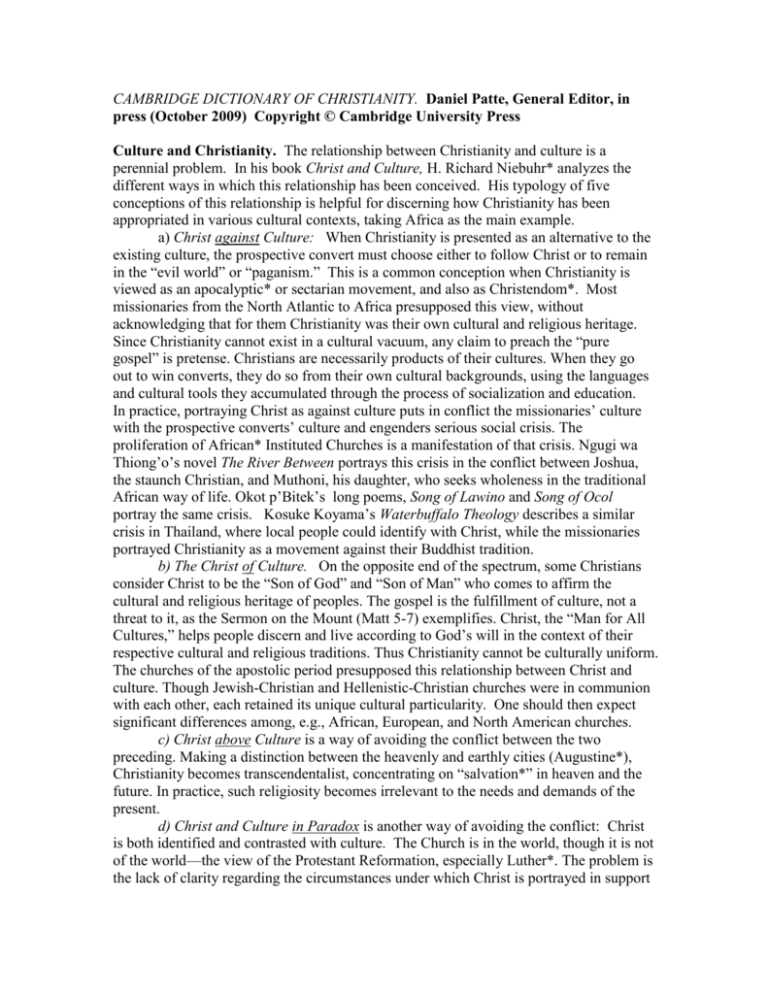
CAMBRIDGE DICTIONARY OF CHRISTIANITY. Daniel Patte, General Editor, in press (October 2009) Copyright © Cambridge University Press Culture and Christianity. The relationship between Christianity and culture is a perennial problem. In his book Christ and Culture, H. Richard Niebuhr* analyzes the different ways in which this relationship has been conceived. His typology of five conceptions of this relationship is helpful for discerning how Christianity has been appropriated in various cultural contexts, taking Africa as the main example. a) Christ against Culture: When Christianity is presented as an alternative to the existing culture, the prospective convert must choose either to follow Christ or to remain in the “evil world” or “paganism.” This is a common conception when Christianity is viewed as an apocalyptic* or sectarian movement, and also as Christendom*. Most missionaries from the North Atlantic to Africa presupposed this view, without acknowledging that for them Christianity was their own cultural and religious heritage. Since Christianity cannot exist in a cultural vacuum, any claim to preach the “pure gospel” is pretense. Christians are necessarily products of their cultures. When they go out to win converts, they do so from their own cultural backgrounds, using the languages and cultural tools they accumulated through the process of socialization and education. In practice, portraying Christ as against culture puts in conflict the missionaries’ culture with the prospective converts’ culture and engenders serious social crisis. The proliferation of African* Instituted Churches is a manifestation of that crisis. Ngugi wa Thiong’o’s novel The River Between portrays this crisis in the conflict between Joshua, the staunch Christian, and Muthoni, his daughter, who seeks wholeness in the traditional African way of life. Okot p’Bitek’s long poems, Song of Lawino and Song of Ocol portray the same crisis. Kosuke Koyama’s Waterbuffalo Theology describes a similar crisis in Thailand, where local people could identify with Christ, while the missionaries portrayed Christianity as a movement against their Buddhist tradition. b) The Christ of Culture. On the opposite end of the spectrum, some Christians consider Christ to be the “Son of God” and “Son of Man” who comes to affirm the cultural and religious heritage of peoples. The gospel is the fulfillment of culture, not a threat to it, as the Sermon on the Mount (Matt 5-7) exemplifies. Christ, the “Man for All Cultures,” helps people discern and live according to God’s will in the context of their respective cultural and religious traditions. Thus Christianity cannot be culturally uniform. The churches of the apostolic period presupposed this relationship between Christ and culture. Though Jewish-Christian and Hellenistic-Christian churches were in communion with each other, each retained its unique cultural particularity. One should then expect significant differences among, e.g., African, European, and North American churches. c) Christ above Culture is a way of avoiding the conflict between the two preceding. Making a distinction between the heavenly and earthly cities (Augustine*), Christianity becomes transcendentalist, concentrating on “salvation*” in heaven and the future. In practice, such religiosity becomes irrelevant to the needs and demands of the present. d) Christ and Culture in Paradox is another way of avoiding the conflict: Christ is both identified and contrasted with culture. The Church is in the world, though it is not of the world—the view of the Protestant Reformation, especially Luther*. The problem is the lack of clarity regarding the circumstances under which Christ is portrayed in support of or against culture. Who has the authority to decide? In the modern Christian missionary enterprise, this authority has been vested in missionaries, who in general were biased in favor of their own cultures and against the cultures where they are guests. e) Christ the Transformer of Culture portrays Christ as making all things new (Rev. 21:5). Conversion is viewed as a challenge for the converts to change their ways and become new beings. Paul’s conversion is often cited as an example. He was transformed from a “persecutor” of Christians to a “perfector” of Christianity. Yet “transformation” presupposes that the earlier way of life is not abandoned; it is transformed through adoption of new insights and commitments. In practice, the ingredients of transformation are most often taken from the culture of the missionaries; the resulting change is then comparable with any other process of acculturation*. In Africa, most cultural changes under colonial rule and missionary tutelage have been of this kind. Thus many of the African elite blamed the modern Christian missionary enterprise for the cultural alienation which Africans have suffered under the pretext of modernization. These five perspectives on the relationship between Christianity and culture are often simultaneously present in a given cultural context and/or a given denomination, causing tensions and confusions and factions. This is the case in Africa. Part of the cultural crisis in Africa arises from the lack of consensus amongst Christians and churches on the most relevant and constructive approach to reconcile Christianity and culture. JESSE N.K. MUGAMBI History as a Theological Concept. History is a theological concept because Christians believe in the incarnate* presence of God in history. The emergence of western historical consciousness and critical methods for the study of history (historiography*) raised a twofold question for theologians in Western Europe and North America: How does God act in history? Can evidence of God’s presence be acquired from historical knowledge? H. Richard Niebuhr’s* typology of relations between Christ and culture works well for the relations between God and history. (1) God against history is the type of mutual and total opposition, evident in apocalyptic* and sectarian views that anticipate the imminent end of history and regard history itself as fallen, corrupt, and passing away. God acts only to end history, and knowledge of God is strictly supernatural, based on miraculous disclosures. (2) God above history is the view of mainstream Catholic theology. Augustine* posited two cities, heavenly and earthly, in which Christians live. World history transpires in the earthly city, while the city of God is the realm of eternal salvation*. The cities are not disconnected, and a hierarchical synthesis forms between them. God acts in the historical realm, but principally to judge and confute worldly designs. (3) God of history is a view that espouses an organic relationship between God and history. God is the immanent power or spirit of history, moving the historical process and manifesting godself in it. Here the concept of God* is itself historicized, and God can be known from an understanding of the depth and purposes of history. Hegel* is the preeminent exemplar of this type with his image of the divine idea as a weft that drives across the warp of human passions, weaving the fabric of world history. (4) God and history in paradox represents a form of dualism by contrast with the separatism of God against history, the synthetic view of God above history, and the holism of the God of history. This is the view of the Protestant Reformation, especially Luther*. Christians are subject to the tension of obedience to two authorities or kingdoms, which do not agree and cannot be synthesized, but must be accepted. The relationship between God and history is paradoxical and cannot be fully understood. (5) God the transformer of history modifies the third and fourth types. Against the third type, it expresses a stronger differentiation between God and history. Against the fourth type, it emphasizes the transformative activity of God in history; it recognizes history to be a realm of tragic conflict in which good can be brought out of evil; and it believes that historical knowledge can serve as corroboration but not as source of faith. This type is associated with some forms of Protestant liberalism*. PETER C. HODGSON

